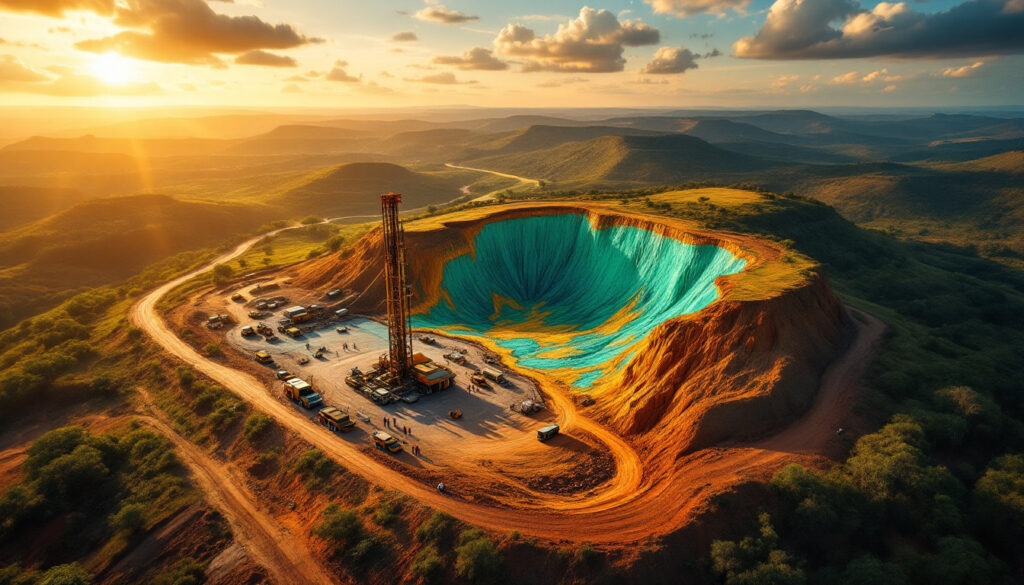What Makes This Investment Significant for the Copper Market?
First Quantum's Strategic Entry into Prospect Resources
First Quantum's investment of $15.2 million represents a 36% premium to Prospect's previous closing price of 11c per share and a 28% premium to its 20-day volume-weighted average price (VWAP) of 11.7c. The acquisition grants FQM a 15% cornerstone stake in Prospect, an ASX-listed junior explorer with an $80 million market capitalization. As a major copper producer in Zambia, FQM contributes 402,000 tonnes of annual copper production from its Sentinel and Kansanshi mines, accounting for approximately 13% of Zambia's total output. The Mumbezhi project, located 25km from FQM's Sentinel mine, boasts a maiden resource estimate of 107.2 million tonnes (Mt) at 0.5% copper, containing 514,600 tonnes of copper.
Prospect CEO Sam Hosack emphasized the strategic value: "Bringing First Quantum into the fold as both a strategic cornerstone shareholder and technical partner offers exceptional value-accretive opportunities for both parties". The proximity to Sentinel, which shares a similar geological setting, enables FQM to leverage regional expertise to accelerate Mumbezhi's development.
The Mumbezhi deposit lies within Zambia's Central African Copperbelt, a region hosting world-class deposits like Kamoa-Kakula (Democratic Republic of Congo) and Khoemacau (Botswana). This belt is the fastest-growing copper domain globally, contrasting with stagnating copper production trends in traditional powerhouses Chile and Peru.
When comparing resources, Mumbezhi's grade of 0.5% Cu is moderate compared to the exceptional 2.8% Cu at Kamoa-Kakula, but its strategic location near First Quantum's existing processing infrastructure significantly enhances its economic viability. First Quantum's smelting capacity expansion at Kansanshi to 400,000 tonnes per annum creates a natural synergy for processing Mumbezhi's future copper output.
The Strategic Value of the Mumbezhi Project
Mumbezhi's maiden resource places it among the largest pre-development copper resources on the ASX. The project spans two mining licenses and is adjacent to three major deposits: Sentinel, Kansanshi, and Fishtie. Zambia's government aims to increase national copper production from 763,000 tonnes (2024) to 3 million tonnes by 2031, with Mumbezhi positioned as a key contributor.
Hosack highlighted Mumbezhi's potential: "This investment strongly validates our conviction for scale at Mumbezhi…[and] supports Zambia's 2031 strategy".
The Nyungu Central and Kabikupa deposits within Mumbezhi host oxide and sulfide copper mineralization, amenable to open-pit and underground mining. Phase 2 drilling targets high-grade zones at Nyungu North and South, which exhibit geochemical anomalies similar to Sentinel's mineralization.
Zambia has implemented favorable fiscal policies to attract copper investment, including reduced mineral royalty rates for new mines and tax incentives for value-addition activities. These policies, combined with Mumbezhi's strategic location near existing roads, power infrastructure, and First Quantum's processing facilities, significantly reduce the capital expenditure required for potential development.
How Does This Deal Benefit Both Companies?
Advantages for Prospect Resources
Prospect raised $18.5 million total ($15.2 million from FQM, $2.8 million from Eagle Eye Holdings), providing liquidity for its Phase 2 drilling program. The program commits $2.5 million to explore targets outside Nyungu Central, with drilling set to commence this quarter.
Hosack noted the partnership grants access to FQM's "regional exploration expertise," accelerating target generation and resource expansion.
The technical working group established under the agreement will integrate FQM's geophysical data and Prospect's grassroots exploration, optimizing drill targeting.
Prospect's exploration timeline includes completing Phase 2 drilling by Q4 2024, with an updated resource estimate expected in Q1 2025. If successful, preliminary economic assessment studies could begin by mid-2025. Canaccord Genuity's 40c price target for Prospect represents a significant premium compared to other ASX-listed copper explorers, which typically trade at $50-70 per tonne of contained copper versus Prospect's current $33 per tonne.
First Quantum's Strategic Benefits
FQM secures board representation and rights to maintain its 15% stake in future equity raises. The 18-month standstill agreement prevents FQM from acquiring additional shares without Prospect's consent, ensuring strategic alignment.
Analyst Tim Hoff (Canaccord Genuity) raised Prospect's price target to 40c, citing "potential resource upside" from Phase 2 drilling.
FQM's Kansanshi smelter, expanding to 400,000 tpa, could process Mumbezhi's sulfide ores, reducing reliance on third-party concentrates.
The integration of Mumbezhi into First Quantum's supply chain could reduce processing costs by approximately $0.15-0.20 per pound of copper, generating annual savings of $15-20 million at full production. This investment aligns with FQM's broader portfolio strategy in Africa, which focuses on establishing regional hubs with multiple satellite deposits feeding centralized processing facilities, as demonstrated by their successful model at Kansanshi.
What Does This Mean for Zambia's Copper Industry?
Zambia's Copper Growth Strategy
Zambia produced 763,000 tonnes of copper in 2024, with FQM contributing 53% (402,000 tonnes). The government's 2031 target (3Mtpa) requires a 14% annual growth rate, necessitating $20 billion in investments.
Hosack affirmed, "We aim to make a material contribution to the Zambian strategy 2031".
Zambia's copper belt hosts 6% of global copper reserves, yet underinvestment has left resources underdeveloped compared to the DRC.
Zambia's mining license approval process has improved significantly in recent years, with exploration permits now being processed within 60-90 days compared to the previous 6-12 months. This expedited timeline has attracted increased investment. The country's mining royalty rates range from 5-10% depending on copper price dynamics, compared to Botswana's 3-5% and the DRC's 3.5%, though Zambia's overall tax stability and security environment offer compensating advantages.
Regional Copper Industry Context
The Central African Copperbelt accounts for 70% of global cobalt and 30% of copper production. Kamoa-Kakula (DRC) produces 400,000 tpa, while Khoemacau (Botswana) targets 130,000 tpa by 2026.
FQM's investment reflects a "long-term commitment to Zambia's copper renaissance," as stated in their press release.
Sedimentary-hosted deposits like Mumbezhi offer scalability but require higher capital expenditure due to lower grades.
The global copper market transition to renewable energy is dramatically accelerating copper demand. Electric vehicles require approximately 83kg of copper per vehicle, more than double the amount used in internal combustion engine vehicles. Solar and wind energy systems consume 5-6 tonnes of copper per megawatt, compared to 1 tonne for traditional power generation. These demand drivers support Goldman Sachs' projection of copper prices reaching $12,000 per tonne by 2030, creating a highly favorable environment for new copper projects.
What's Next for Prospect Resources?
Accelerated Exploration Program
Phase 2 drilling will test Nyungu North (5km strike length) and West Mwombezhi, aiming to double the resource to 1Mt Cu.
Hosack stated, "There is ample potential resource upside waiting to be unlocked".
Airborne electromagnetic surveys identified conductive anomalies at Nyungu South, suggesting sulfide enrichment zones.
The detailed drill program budget allocates $1.8 million for 15,000 meters of diamond drilling (average depth 300m) and $0.7 million for geophysical surveys and assays. Results are expected to be released in batches beginning in Q3 2024, with final assays due by year-end. Prospect plans to conduct metallurgical test work simultaneously, with a focus on differentiating recovery rates between oxide ores (typically 85-90% recovery) and sulfide ores (92-95% recovery) to optimize future processing decisions.
Future Development Potential
Prospect's Arcadia lithium project sale (2022) generated $378 million, demonstrating its capability to monetize assets.
Canaccord's Hoff highlights "blue-sky potential" if Mumbezhi replicates Arcadia's success.
A feasibility study for Mumbezhi is slated for 2026, contingent on resource expansion.
Financial modeling indicates Mumbezhi could achieve an NPV of $300-900 million depending on resource size and copper prices. At the current resource (514,600t Cu) and $8,000/t copper price, the base case NPV is estimated at $300 million. If Phase 2 drilling expands the resource to 1Mt Cu and copper prices reach $10,000/t, the NPV could exceed $650 million. In an optimistic scenario with 1.5Mt Cu and $12,000/t copper, the NPV approaches $900 million. Discussions with First Quantum regarding potential offtake agreements are likely to advance following resource expansion, with preliminary terms potentially including preferential processing at Kansanshi in exchange for equity financing of mine development.
FAQ About the First Quantum-Prospect Resources Deal
What is the premium First Quantum is paying for its stake in Prospect Resources?
FQM's 15c per share investment represents a 36% premium to Prospect's 11c closing price and a 28% premium to its 20-day VWAP.
How much copper does First Quantum currently produce in Zambia?
FQM produces 402,000 tonnes annually from Sentinel (220,000t) and Kansanshi (182,000t).
What is the size of Prospect's Mumbezhi copper resource?
The maiden resource estimate for Mumbezhi is 107.2Mt at 0.5% copper for 514,600t of contained copper metal, making it one of the largest pre-development copper resources on the ASX.
What governance rights does First Quantum receive?
FQM gains board representation, technical working group participation, and rights to maintain its 15% stake in future raises.
How does this investment align with Zambia's national copper strategy?
The investment supports Zambia's goal to increase copper production to 3 million tonnes per annum by 2031, with Prospect's CEO noting they aim to make "a material contribution to the Zambian strategy 2031." This strategy is further supported by ongoing copper clean energy investments from major miners looking to position themselves in the growing green energy sector.
For investors interested in this sector, understanding the fundamentals of mining stocks guide resources can provide valuable context about how to evaluate opportunities like Prospect Resources within the broader copper market.
Ready to Spot the Next Major Copper Discovery Before the Market?
Discovery Alert's proprietary Discovery IQ model delivers instant notifications on significant mineral discoveries across the ASX, transforming complex exploration data into actionable investment insights. Explore why major discoveries like Mumbezhi can generate substantial returns by visiting Discovery Alert's dedicated discoveries page.




